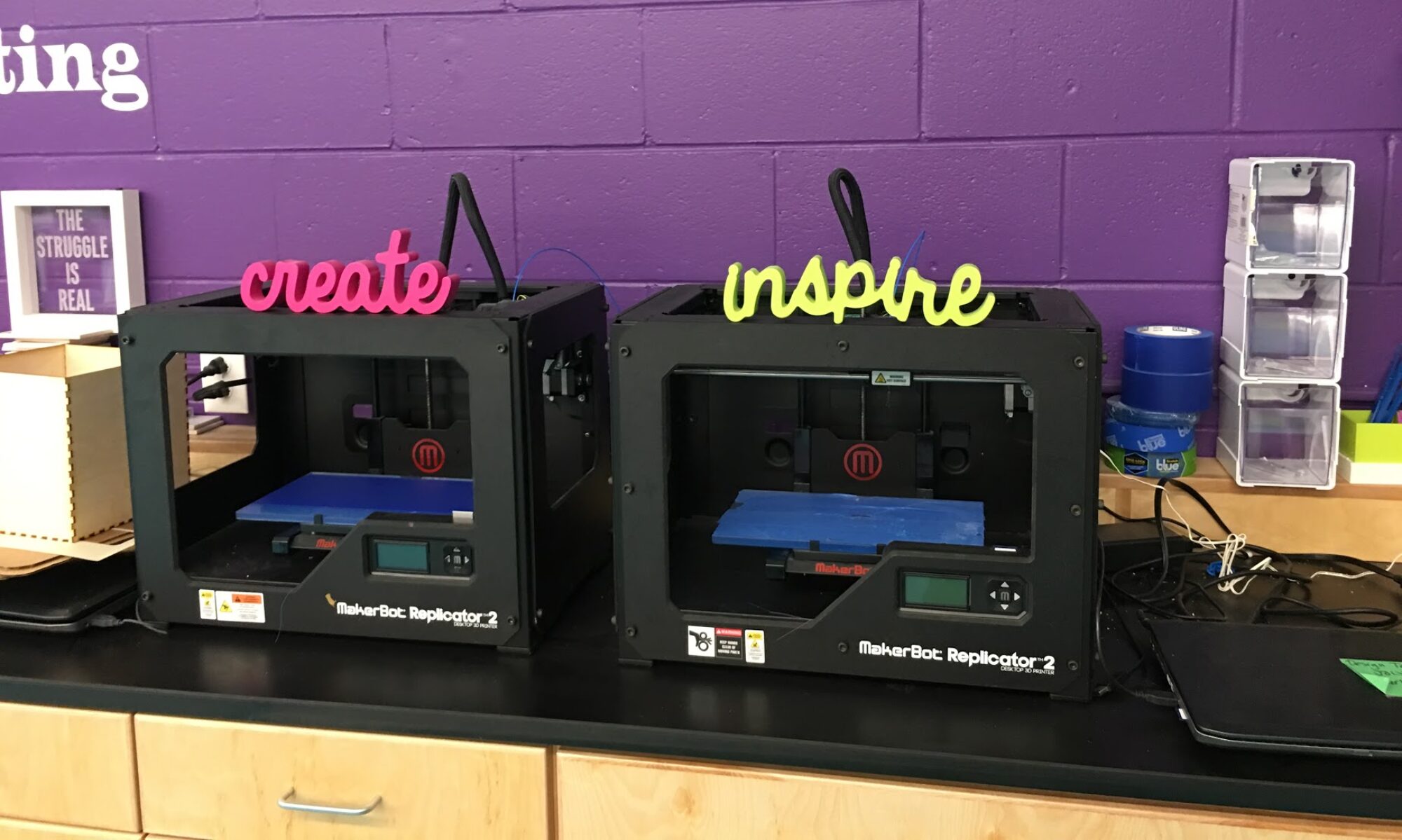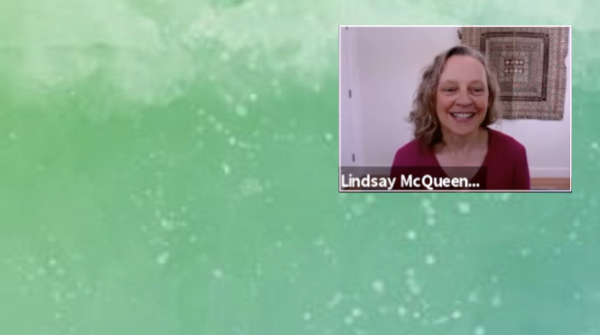Lindsay McQueen, a middle school science educator at Edmunds Middle School, in Burlington VT, originally presented “Challenging Simplified Notions About Health Equity in the Middle Grades” in January 2021. She presented it as part of the 2021 Middle Grades Conference at the University of Vermont.
Below please find a video recording of the workshop, optimized for solo or team playback. Additionally, we present an annotated transcript of this presentation for your use.
Recording

Audio-only version
Resources
- Slides from “Challenging Simplified Notions of Health Equity”
- Unfortunate or Unjust? resources (Google Slides)
- Investigate Health Equity resources (Google Slides)
- Student-produced slides: Racism & Health Justice
Annotated Transcript
All right. Good morning, everyone. Just to let you know a little bit about me, I am a health educator, middle school, 6th, 7th and 8th grade at Edmunds Middle School in Burlington, VT.
And what I hope to do today is share a little bit of the purpose and background behind my action research project: a health equity unit that I designed and used for the first time this year.
And in that I’m also going to then zoom in on one lesson in particular, just to give you a little bit more sense of that. Then we’ll pause there for some comments and questions. And after that, I’m going to share some initial observations about learning and a few of the projects that students created to give you a sense of what the outcome was.
Designing a health unit around equity
The purpose, really the grounding and the inspiration, was that I had already been dreaming about redesigning a unit in health class, and seeing the work actually that the sixth grade humanities team does at my school.
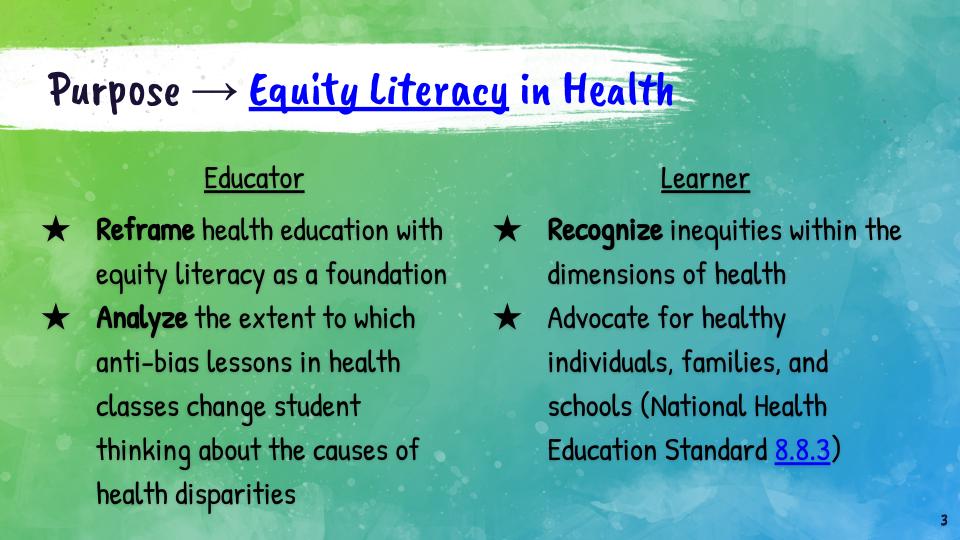
The humanities team in 7th and 8th grade was what I went into the Middle Grades Institute (MGI) with last summer. And having a real grounding with the equity literacy framework through Paul Gorski. Between those two, I decided that the purpose here was really to design a new unit that uses equity literacy as the foundation. And also as the umbrella of everything that we do through health class.
I specifically wanted to analyze the extent to which really intentional anti-biased lessons change students’ thinking about the causes of health disparities.
So: looking at health equity and health disparities. What I was hoping learners would take from this was being able to recognize inequities within the different dimensions of health that we look at.
Finally, the actionable part is to advocate for healthy individuals, families, and schools, which is part of the national health education standards. So bringing that in and grounding that all in the equity work.
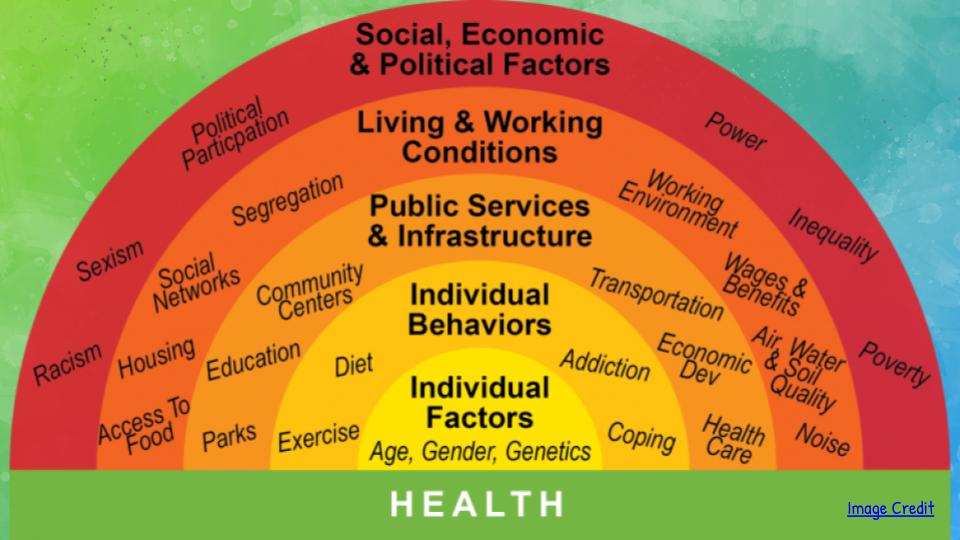
When I talk about simplified notions of health, I think a lot of what have done over the years in health education is really focused on that second, darker yellow band there around individual behaviors. Diet. Exercise. Addiction. Coping.
So much of traditional health education is around diet and exercise. And talking about prevention of prevention in terms of drugs and alcohol learning, stress management techniques and so on.
It’s always not really sat very well with me because I thought there’s more to this. But how do I get there with middle-schoolers? How do I go beyond thinking that health is all up to them managing their sleep cycles and managing their diet and so on?
And so I use that image of the rainbow as an intro to the unit talking about that band there of individual behaviors and factors. But then I also bring up this larger context of all the other socio-economic and political factors: living and working conditions, the services that go into our understanding of healthy individuals, and healthy communities, and a healthy nation.
This is also called the social determinants of health. And it’s been a hard thing to access with middle-schoolers. A lot of the reading that I’ve done is even hard for adults to access. Like, it doesn’t even really roll off the tongue very easily.
So I was trying to think of a different way to approach this.
And then these inquiry questions were also what helped ground the unit:
To what extent is health determined by individual choices and behavior?
Factual: What is the difference between health equity and inequity/disparity?
Conceptual: Why do health disparities exist?
Actionable: What is important to teach our community about health and equity?
“Health for All: An Introductory Unit”
So the intro unit is called Health for All. And the overarching question is how much, or to what extent is health determined by individual choices and behaviors?
We started off getting a real understanding of what is the difference between health equity and inequity. I’m trying to get some solid definitions there for disparity, right?
And then this why question — which is often a challenge to do — why do health disparities exist? And taking a look at some of the different reasons, then ending the unit with an actionable piece.
So: what is it that’s important to learners and students to teach our community about health and equity? Making sure that that piece is built in as well.
Here’s the overview of the unit:
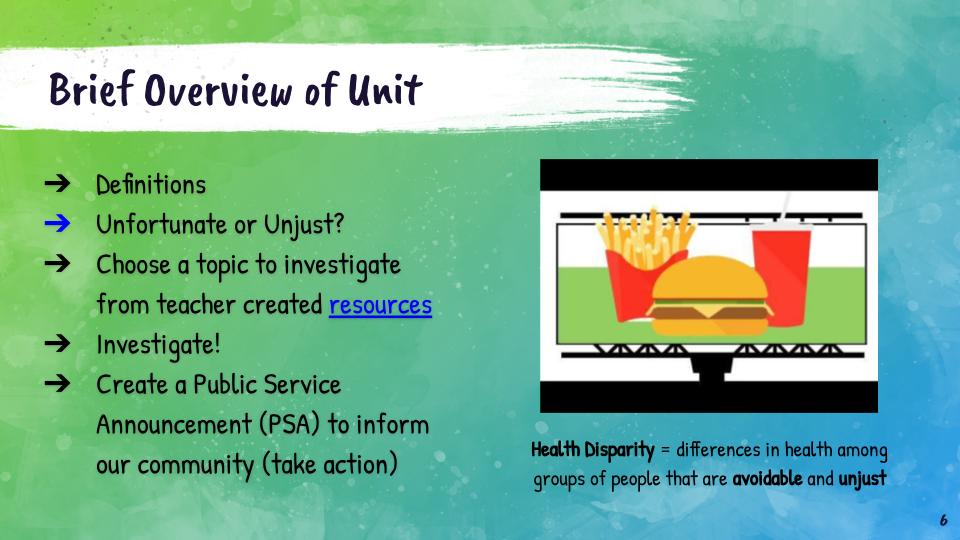
I mentioned the definitions, so getting a grounding in what these words even mean in terms of health. A lot of the 7th and 8th graders come into health class with some prior knowledge and learning through the 6th grade humanities program. And it’s a really great way to connect that to a different discipline now.
We watch this short video and really identify that health disparities are avoidable and unjust, and they are differences in health among groups of people.
Then we do a specific lesson called “Unfortunate or Unjust?”
Finally we choose a topic to investigate.
That’s the action piece: creating a public service announcement to inform our community and actually be able to do something to address this.
“Unfortunate or Unjust?”
Okay, so this lesson is inspired by, as I mentioned, the 6th grade team’s lesson called “Unfortunate or Unjust?” The purpose of this was to raise critical consciousness. It’s a series of 10 statements.
And what we do is stand up or sit down based on whether students think the statement is unfortunate or actually unjust. This is also meant to spark interest in what they then want to go and investigate.
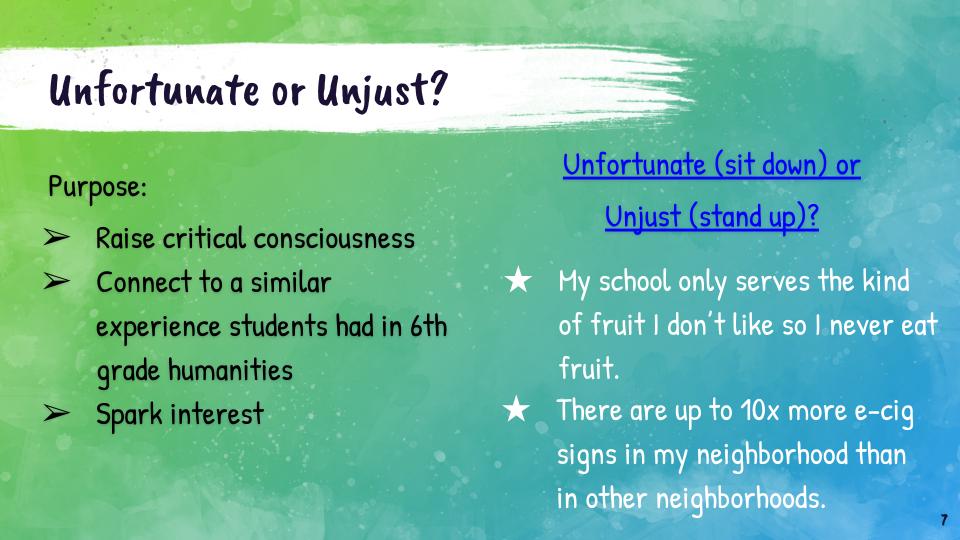
So here’s one that addresses talking about diet: “My school only serves the kind of fruit I don’t like, so I never eat fruit.”
For the most part, everyone stays seated. Everyone’s sitting in their chair. (This is obviously COVID adapted. Normally we would move around the room, but this is just stand up or sit down.)
We talk a little bit about the fruits that they don’t like, just trying to get some understanding there that that’s just unfortunate. Like, that’s not targeting any particular social identity group. But it might be someone doesn’t eat as much fruit as would be recommended because they don’t like it.
As opposed to the other statement.
“There are up to 10 times more e-cigarette ads or signs in my neighborhood than in other neighborhoods.”
This gives a chance for anyone who’s interested in exploring this topic more, around how big tobacco companies intentionally target youth in marginalized communities through marketing and advertising. Again, part of this is to raise critical consciousness and to also give learners a chance to see what are some different topics that they can then go and investigate.
Students are in many cases able to make the connection to why something is unfortunate.
They are able to identify the social identity group that is being marginalized.
And so then we can go back to the rainbow graphic and say, “This is an example of racism. This is an example of sexism.” Being able to put that in the larger context of that graphic.
Then a lot of the language for middle schoolers too, is to say that health also just depends on where we work, where we live, and where we play. All of those larger society factors that can influence health beyond just our individual behaviors.
Environmental Health & Environmental Justice
One of the topics that that is offered in the investigation is around environmental health and environmental justice.
One of the questions that is unjust or one of the statements that I have in there is: “My community is next to a landfill. And this is the only place that I can live.”
And there was some really interesting conversation among students. It’s not necessarily at that point in time that we say this is definitely unjust, but it allows for the conversation to happen where some say, well, that’s just too bad, but someone has to. Not really understanding how communities are intentionally placed. Not understanding yet that where landfills are built or power stations is intentional.
And so some of that again is just sparking that raising that critical consciousness around what they’re thinking. Why sometimes some of the unjust statements would actually start off as kids thinking that they’re unfortunate.
But what are students interested in investigating?
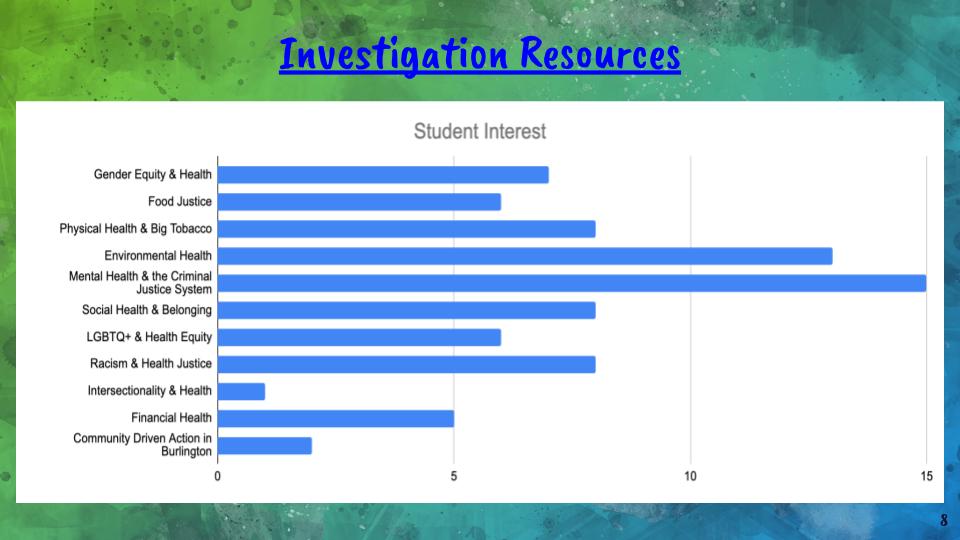
Now, this was a Google form of student interest on which area, which topic they were interested in investigating more. And it’s a lot. There’s a lot there. I was really trying to provide a lot of choice so that everyone felt like they had something that they could access and interact with.
And there were even some topics beyond this that learners came up with. Someone said they wanted to investigate equal pay and the income gap for gender inequities. So we just added those on based on what other interests came up.
From this, I learned a lot about what students were interested in finding out more about.
Clearly the environmental health piece that I had mentioned, and then mental health and the criminal justice system was something that students were very interested in investigating more.
So then what we did was we grounded that in a real understanding of why these health disparities exist.
After that, they had a chance to choose one of those topics and investigate that more and finally create an action piece. We know it’s important is to be able to take action so that students aren’t just left with what they’ve learned about all of these inequities, and a feeling of… now what do we do with it?
Three Examples of Public Service Announcements (PSAs)
Instead, at the end of the unit, what they had a chance to do was create a public service announcement.
These are just three examples from what they did.
Racism & Health Justice Slideshow
Environmental Justice Video PSA
Kindness Kits
“Kindness Kits” are what some seventh graders did to take action, which was of their own initiative.
They were investigating gender inequities and health, in terms of not having access to, or not being able to talk comfortably about, having menstrual pads available at school. So they decided to put together these kits that have pads in them. And they have a note to anyone who needs them. Students really just did this of their own initiative. They ran with it and decided that they want to make these available for anyone at our school to pick up for themselves or for someone else. That’s how they decided to take action in this case.
Sample Takeaways
This is again from a short Google form. Just some things that the students said that they thought was important from their projects.
- “I would hope that it would help open a conversation about gender equity.”
- “I hope that from my PSA, people who are part of the LGBTQ+ community will ask for help when needed and can talk to anyone and feel more comfortable around anyone.”
- “It will help raise awareness to racism because it’s not talked about enough.”
- “I think the main idea was to educate people on this issue [mental health and the criminal justice system] because it is not talked about enough.”
Helping to raise awareness and helping to open up the conversation that is sometimes uncomfortable and not talked about. That was that was a big piece for them. This is just a sample, but there was a common theme with all the responses to the Google form.
Next Steps
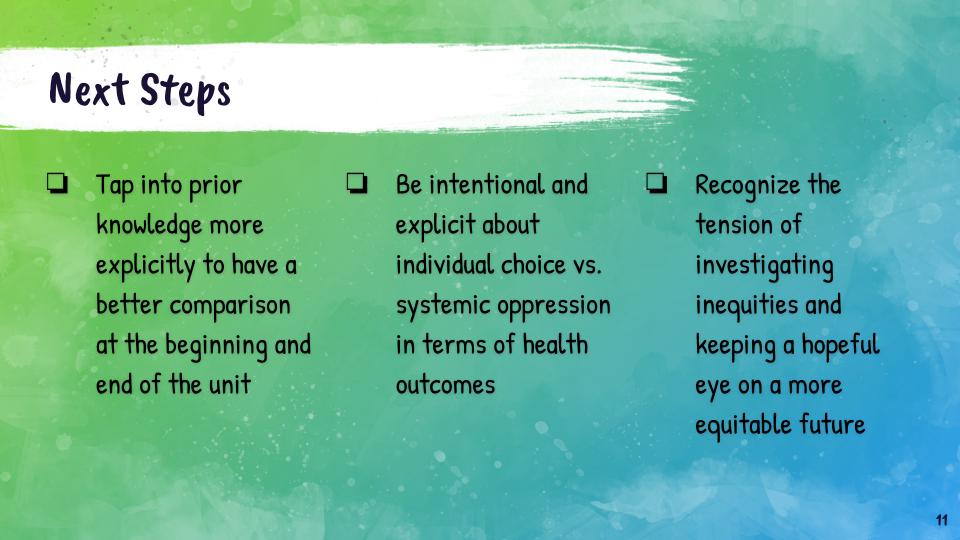
So my next steps: I want to be more explicit in tapping into prior knowledge.
I did a lot of listening and observing from lesson to lesson, but I didn’t feel like at the end, I had a real, like, this is before thinking, and this is after thinking that the learners had for themselves.
And so the next time around, I would like to just be really explicit about this is what I used to think, and this is what I now think.
Then I need to be more intentional and explicit and develop my own current courage around talking about individual choice versus systemic oppression in terms of health outcomes. I felt nervous about doing that when we first came back to school in September because of the dual pandemics that we are experiencing.
I wanted to really recognize the tension of students identifying or self-identifying with these social identities. And then the health outcomes that we know exist and not feeling like this is a done deal for me.
So I’m always trying to balance that.
Being able to talk about things that are uncomfortable and also providing that hope, with an eye towards a more equitable future. And I’m certainly finding my co-conspirators at school help to, to have the courage and continue to develop the courage to do that.
Those are the things that I want to keep working on.
Lindsay McQueen’s Slides
The 2021 Middle Grades Conference was made possible by the Middle Grades Collaborative, a combined project of the University of Vermont, St. Michaels College, Castleton University, and Northern Vermont University.
